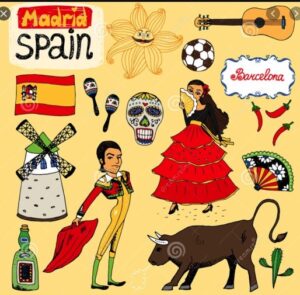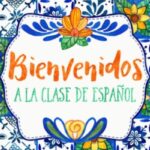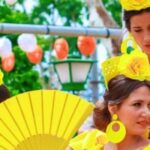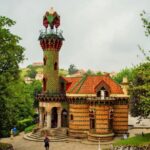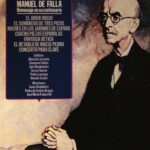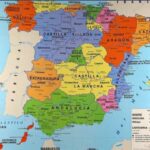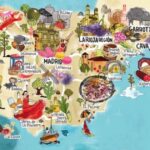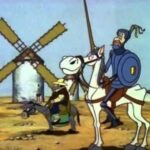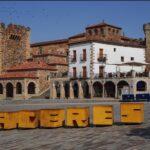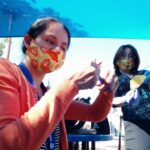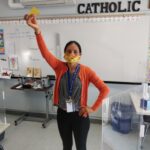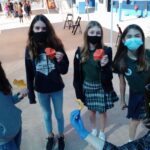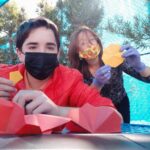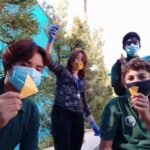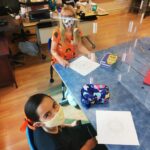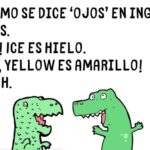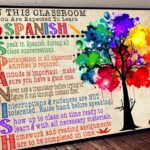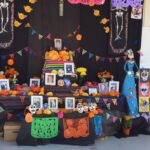
Junior Yard Spanish
Transitional Kindergarten
Spanish language and culture are introduced through illustrated stories, flashcards, songs, videos, and art and craft activities. Activities like acting, singing, dancing, painting and playing games are enjoyed immensely by our little students and are a great way to enhance their memory. Because of their young age, we believe in the importance of a full immersion in the L2 language. Little students get easily used to a second language and are eager to copy and say words in Spanish. Students are taught the sign of the cross, pronunciation of letters and words, age-appropriate vocabulary, Latino/Hispanic/Spanish holidays/traditions, and simple sentence structures. Specifically, students learn according to their age and needs: greetings/goodbyes; expressing feelings; asking/responding to name; basics of gender/number agreement (adjectives); animals; classroom commands and routines; colors; numbers 1-20; weather expressions; dates; days of the week; foods/drinks; opposites; body parts; and shapes.
Kindergarten
Spanish language and culture are introduced through illustrated stories, flashcards, songs, videos, and art and craft activities. Activities like acting, singing, dancing, painting and playing games are enjoyed immensely by our little students and are a great way to enhance their memory. Because of their young age, we believe in the importance of a full immersion in the L2 language in a warm, welcoming environment. Little students get used to a second language and are eager to copy and say words in Spanish. Students are taught the sign of the cross, to pray Glory and Angel of my guard, pronunciation of letters and words, age-appropriate vocabulary, Latino/Hispanic/Spanish holidays/traditions, and simple sentence structures. Specifically, students learn according to their age and interests: greetings/goodbyes; expressing feelings; asking/responding to name; basics of gender/number agreement (adjectives); some verbs of movement; animals; classroom commands and routines; colors; numbers 1-20; weather expressions; dates; days of the week and months; foods/drinks; opposites; body parts; and shapes.
First Grade
Students are exposed to the Spanish language and culture and are encouraged to make attempts in the second language from the very beginning of the school year. All the activities are developed in a relaxed and joyful class context. The target language is continuously used in class.
A great way to keep students highly interested and motivated is to approach the language and culture through interactive and fun activities. Acting, singing, dancing, painting and playing games are accurately related to the age, level and interests of our little students. Students learn the sign of the cross; to pray Glory; Hail, Mary and Our Father; pronunciation of letters and words, age-appropriate vocabulary, and more complex sentence structures. Students are guided to experience the Hispanic culture through creative, art and craft activities.
Specifically, students learn: greetings/goodbyes; expressing feelings; asking/responding to name; basics of gender/number agreement (adjectives); some verbs of movement; animals; classroom commands and routines; colors; numbers 1-30; weather expressions; dates; days of the week and months; family members; foods/drinks; parts of the body; clothes; opposites; shapes; school supplies; questions words. Students are expected to add more detail and to demonstrate more control than Kindergarten students.
Instruction is differentiated for native speakers at every grade level.
Second Grade
Students are constantly encouraged to engage in brief conversations, give and follow simple instructions, ask and answer easy questions. They are invited to express what they like and dislike. They can read, write and understand simple sentences and expressions.
The target language is constantly used in class to create a full immersion experience.
Other school subjects are explored in Spanish, all through a variety of fun and interactive activities that make learning Spanish an enthusiastic experience. Students learn prayers: Glory; Hail, Mary and Our Father. They reinforce spelling and pronouncing words in Spanish. Subject matter includes greetings and introductions, goodbyes and courtesy expressions, family, friends, descriptions of people using the verb “ser/to be” and adjectives, home, clothing, and colors. School, activities associated with school, days of week, time telling, numbers 30-50, animals descriptions are explored through music, dancing, art and craft activities, physical interaction, video and selected readings. Finally, students learn about parts of the body, food, seasons, and weather.
Instruction is differentiated for native speakers at every grade level.
Senior Yard Spanish
Third Grade
Third grade students are guided, step by step, through a learning process where the listening, speaking, writing and reading activities become more accurate and in detail. The target language is constantly used in class to create a full immersion experience.
Videos, songs, stories, pictures, acting, painting and games are the perfect combination to highly enhance acquisition and memorization of a bigger range of vocabulary and Spanish/Latino holidays and traditions. Students love moving and having fun while approaching and/or reinforcing a new topic in a totally stress-free environment. They are also very proud of the work they can create with their own hands. The interactive notebooks are a clear example of it. Spanish classes start with prayers: Glory; Hail, Mary and Our Father. Through guided reading, they reinforce spelling and pronouncing words in Spanish. Subject matter includes greetings and introductions, goodbyes and courtesy expressions, family, friends, descriptions of people using the verb “ser/to be” and adjectives, home, clothing and colors. School, activities associated with school, days of week, time telling, numbers 50-100, animals, are explored through music, physical interaction, video and a variety of selected readings. Finally, students learn about parts of the body, food, healthy living, seasons, weather, and visiting places. Expectations for third grade students are appropriately higher and more challenging. Students are expected to write in complete sentences.
Instruction is differentiated for native speakers at every grade level.
Fourth Grade
Fourth graders continue their challenging work. Students share prayers: Glory; Hail, Mary and Our Father. They learn to improve communication skills, broaden their cultural perspectives, and learn quite a bit of Spanish language and culture (focusing on particular countries of the world). Great importance is given to cultural topics and everyday life related readings, videos, songs and art and craft activities in a "solo español/only Spanish" classroom. Specifically, students are able to comprehend and answer questions about a story in Spanish. They are aware of the fact that the way some letters are pronounced is Spanish is different than in English. They understand written language on a variety of topics. Instruction is differentiated for native speakers at every grade level.
Fifth Grade
Fifth graders prepare themselves for the middle school curriculum by continuing their journey into the world of Spanish culture and communication. They encounter grammar in the context of reading and listening in the target language, as well as through structured activities designed to reinforce specific concepts. They approach Spanish in a variety of ways. They memorize prayers, watch videos that describe the costumes and habits of some Spanish speaking countries, sing songs, read articles from ¿Qué tal? magazine, do art and craft activities, and play games to improve their listening and speaking abilities. They do written activities related to videos and songs to improve their grammar and spelling. They are able to engage in simple conversations, provide and obtain information, express feelings and emotions, and exchange opinions. Instruction is differentiated for native speakers at every grade level.
Sixth Grade
We welcome sixth graders to the middle school program with a curriculum that is geared towards improving both fluency and accuracy in speaking and writing. Through drama, music, and art, students learn to describe their world in the present tense, learn Spanish culture, and learn Catholic religious and cultural traditions. Instruction is differentiated for native speakers at every grade level.
Seventh Grade
Seventh grade Spanish consolidates knowledge learned in previous years and sets the stage for more complex concepts. Joy is an integral part of the entire Spanish sequence at Stella Maris, because we recognize that happy children learn best. While standard verb and grammatical structures are covered, readings and cultural traditions are also guided by class interests. In addition to praying, seventh graders use their Spanish to write to the Pope. Instruction is differentiated for native speakers at every grade level.
Eighth Grade
Eighth grade Spanish consolidates the learning from previous years and prepares students for high school Spanish curricula. Priority is given to review of verb forms and tenses, and other grammatical structures, so that students are comfortable with these difficult concepts as they move on in their language studies. Class is conducted in Spanish, and listening and speaking skills are reinforced through frequent oral presentations. Written work provides opportunity for differentiation, especially for new students and for native speakers. Traditions of the Catholic Church play an important part in Hispanic culture, and students continue to learn prayers in Spanish.
| M | T | W | T | F | S | S |
|---|---|---|---|---|---|---|
| 1 | 2 | |||||
| 3 | 4 | 5 | 6 | 7 | 8 | 9 |
| 10 | 11 | 12 | 13 | 14 | 15 | 16 |
| 17 | 18 | 19 | 20 | 21 | 22 | 23 |
| 24 | 25 | 26 | 27 | 28 | 29 | 30 |
Some Pictures
